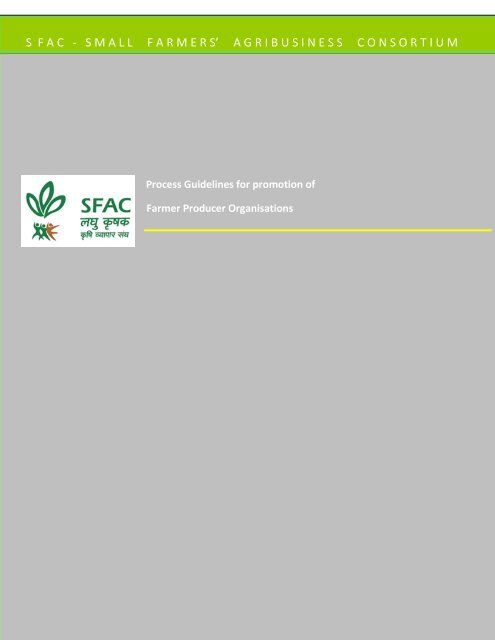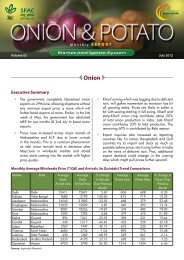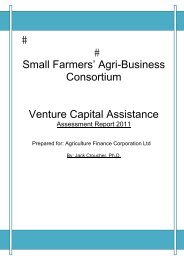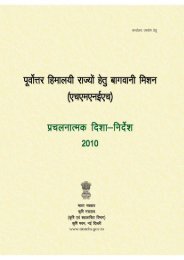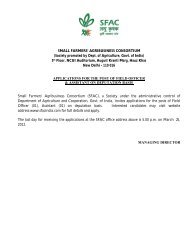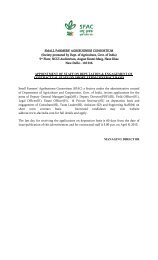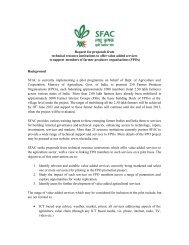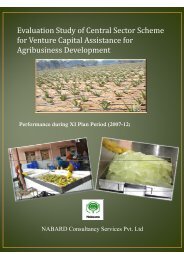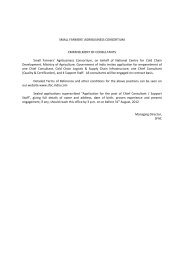FPO process guideline - SFAC
FPO process guideline - SFAC
FPO process guideline - SFAC
You also want an ePaper? Increase the reach of your titles
YUMPU automatically turns print PDFs into web optimized ePapers that Google loves.
S F A C - S M A L L F A R M E R S’ A G R I B U S I N E S S C O N S O R T I U M<br />
Process Guidelines for promotion of<br />
Farmer Producer Organisations<br />
1
S F A C - F P O<br />
P R O C E S S G U I D E L I N E S<br />
Table of contents<br />
1. Purpose of Guidelines<br />
2. Project Considerations – Objective<br />
3. Guiding principles for sustaining Farmer Producer Organization<br />
development<br />
4. Stages of Project Development<br />
5. Project activities and measures of verification<br />
6. Project Outcomes<br />
7. Payment Structure<br />
2
S F A C - F P O<br />
P R O C E S S G U I D E L I N E S<br />
Small Farmers’ Agribusiness Consortium (<strong>SFAC</strong>), a Society promoted by Dept. of Agriculture, Govt. of India, has<br />
been nominated by Ministry of Agriculture to act as a nodal agency to coordinate with various State<br />
governments, civil society partners, private sector, financial institutions, resource persons and other<br />
stakeholders to help in the conduct of baseline studies, promote Farmer Producer Organizations (<strong>FPO</strong>s) across<br />
the country and link producer groups (both existing ones and newly formed institutions) to marketing<br />
opportunities.<br />
The purpose of the project is to collectivize farmers, especially small producers, at various levels across several<br />
states, to foster technology penetration, improve productivity, enable improved access to inputs and services<br />
and increase farmer incomes, thereby strengthening their sustainable agriculture based livelihoods.<br />
The document below delineates the project <strong>guideline</strong>s, stages of project development, key verifiable indicators<br />
and outcomes.<br />
1. Purpose of Guidelines<br />
1.1. <strong>SFAC</strong> has identified suitable civil society, private sector and state level partners in each target State<br />
through a <strong>process</strong> of empanelment based on open bidding to promote new <strong>FPO</strong>s and strengthen<br />
existing ones.<br />
1.2. The purpose of these <strong>guideline</strong>s is to provide guidance to entities on objectives , activities and key<br />
indicators for measuring project performance and impact<br />
2. Project Considerations – Objective<br />
<strong>SFAC</strong>, through the programme, intends to work closely in support of Department of Agriculture & Cooperation<br />
and the various State Governments to enhance production, productivity and profitability of small farmers in the<br />
country. The participant farmers will be supported to identify appropriate crops relevant to their context,<br />
provided access to modern technology though community based <strong>process</strong>es including Farmer Field Schools, their<br />
capacities will be strengthened and they will be facilitated to access forward linkages with regard to technology<br />
for enhanced productivity; value addition of feasible products and market tie up. Farmers will be organized in<br />
small neighborhood informal groups which would be supported under the programme to form<br />
associations/organizations relevant to their context including confederating them into <strong>FPO</strong>s for improved input<br />
and output market access and negotiating power.<br />
Projects Objectives are:<br />
2.1 Mobilising farmers in groups at the village level and build their associations (<strong>FPO</strong>s) at an appropriate<br />
federating point to plan and implement product specific cluster/ commercial crop cycles<br />
2.2 Strengthen farmer capacity through agricultural best practices for enhanced productivity<br />
2.3 Ensuring access to and usage of quality inputs and services for intensive agriculture enhancing<br />
cluster competitiveness<br />
2.4 Facilitate access to fair & remunerative markets including linking producer groups to marketing<br />
opportunities by market aggregators<br />
A results framework detailing for each activities proposed activities, outputs and outcomes is provided in<br />
Annexure 1.<br />
3
S F A C P F O P R O C E S S G U I D E L I N E S<br />
3. Guiding principles for sustaining Farmer Producer Organization development<br />
The Resource institution partner should:<br />
3.1 Focus on shared member needs and common objectives- use more participatory approaches to group<br />
development need to be applied in which the Farmer Group is the decision maker. The final decision on<br />
what the group should do and how it should be done, should be based on group member consensus.<br />
3.2 A range of different organizational approaches and forms should be used - the type of group approach<br />
used (community-based, small group, inter-group association, cooperative, producer association,<br />
income generation-focused, technology-focused etc.) will vary and should be appropriate to the group<br />
objective pursued and the particular stage of development of group members, i.e. their level of<br />
organizational skills, technical knowledge, education and asset base<br />
3.3 Give top priority to promoting sustainability - ensure that groups formed become financially self-reliant<br />
enough to sustain their operations without the continued need for outsider support<br />
3.4 There is an inherent conflict between the role of the member as a “user of the group’s services” and as<br />
“an investor in group business”- ensure that the group savings and capital contributions to the<br />
enterprise continue to grow to ensure that:<br />
a) Member savings or capital contribution requirements are in proportion to their level of use of the<br />
group enterprise’s services; and<br />
b) That incentives to attract member capital are comparatively positive.<br />
4. Stages of Project Development for FOs & <strong>FPO</strong>s<br />
4.1 Village study and preliminary identification<br />
4.1.1 The village study/profile may have been conducted by the team in the prescribed format.<br />
4.1.2 The findings of the profiling may indicate one or more livelihood activities that are predominant<br />
in the area and involve a sizeable number of the poor/women, in which there is a potential for<br />
increasing returns through aggregation. Aggregation can be done for supply of inputs (seeds,<br />
fertilizers, cattle feed, raw materials, credit etc.), management of resources (water, common<br />
land etc.), <strong>process</strong>ing/ value addition, marketing of output.<br />
4.1.3 Identify the activity/s and what can be done through aggregation. Prepare a brief note on the<br />
feasibility analysis<br />
4.2. Feasibility study<br />
Conduct a detailed feasibility study for the particular and the proposed activity. This would include the<br />
following. Prepare formats/questionnaires/interview schedules as required for each of these.<br />
4.2.1. Community Background Study in which the farmer group will be established. Identify, :<br />
• The living conditions of different socio-economic groups in the community<br />
• The needs of the community, especially of the poor<br />
4
S F A C F P O P R O C E S S G U I D E L I N E S<br />
• The way the community solves its problems (e.g does it use traditional methods and/ or<br />
involvement or assistance of outside organizations)<br />
• Social patterns in the community including who talks to whom and why<br />
• Informal and formal organization of men and women ( both mixed and separate)<br />
• Links between the community and supply of services and who controls them<br />
4.2.2. Preliminary assessment of availability of the commodity/service around which producers will<br />
have to be organized – volume, value, market access<br />
4.2.3. Centrality analysis: Whether the commodity/activity is central/significant in the minds of the<br />
community. Whether it contributes (or has potential to contribute) significantly to their<br />
livelihood portfolio<br />
4.2.4. Data collection: Collect relevant secondary and primary data on the commodity in question<br />
and the related factors affecting its procurement/inputs/production/storage/marketing.<br />
4.2.5. Cost-benefit and break-even analysis for the proposed activity/activities of the organization.<br />
4.3 Report and action plan<br />
4.3.1. Prepare a consolidated report, including proposed action plan.<br />
4.4. Organizing<br />
4.4.1. Identification of opinion leaders: Identify opinion leaders from among the producers and form<br />
a representative group of proactive people.<br />
4.4.2. Orientation of leaders: Share the findings of the feasibility study and discuss the need for<br />
formation of an organization to utilize the potential of the particular livelihood activity.<br />
4.4.3. Discussion with village community - Involve the leaders group to organize a series of meetings<br />
of the village community (Gram Sabhas) to discuss the following:<br />
• Necessity for collective action<br />
• Values in collective action<br />
• Findings of feasibility study<br />
• Proposed activities, product- value addition, linkages etc<br />
• Proposed action plan<br />
This communication with the people needs to be repetitive and cannot be done in one<br />
meeting.<br />
5
S F A C F P O P R O C E S S G U I D E L I N E S<br />
4.4.4. Training and exposure of producers: Organize trainings for producers on concepts and roles of<br />
the FO& <strong>FPO</strong> and their own roles as members. If possible, also organize exposure visits to<br />
similar community organizations in the nearby area.<br />
4.5. Formalizing<br />
4.5.1. Visioning: Facilitate formulation of vision and mission of the collective with the promoters.<br />
Develop with them the values on which organization should be based.<br />
• Objectives and plans – Identify specific and realistic goals/objectives to inform the<br />
development of work plans and budgets. Some basic questions addressed through focus<br />
group discussions can help to identify objectives<br />
4.5.2. Design an appropriate organization – objectives, activities, structure, rules, legal form and<br />
basic operating system (work flow) – in consultation with the leaders. Provide them complete<br />
information on each aspect and facilitate decision-making.<br />
• Identify rules including obligations of group members to ensure the smooth running of<br />
the group and avoid conflict within the group<br />
• Identify responsibility for leadership, coordination of logistics, record keeping,<br />
networking, team building, communication and other roles.<br />
4.5.3. Facilitate the election of the Governing Board/ Management Committee and office bearers, as<br />
required depending on the legal form of the organization. Facilitate framing of Vision, Mission,<br />
and Goals and draft the byelaws and other applicable resolutions with the board. Also facilitate<br />
the formation of subcommittees, as required, and clarify their roles and responsibilities.<br />
4.5.4. Opening of bank account: Facilitate opening of a bank account, with signatories as per the<br />
byelaws of the organization.<br />
4.5.5. Collect share capital and other necessary fees: Collect the share capital, membership fees as<br />
applicable from members and deposit in the bank account.<br />
4.5.6. Registration: Complete the documentation required for registration and follow-up the <strong>process</strong><br />
of registration. The Board/office bearers should take responsibility of these activities; we<br />
should have a facilitation role. Obtain the following from the Registrar’s office<br />
• Registration certificate<br />
• Approval of Board<br />
• Copy of Byelaws<br />
• Instructions for operating bank account<br />
•<br />
Please note that registration is not an essential part of formalizing at this stage. The organization may<br />
initiate its operations and register in the appropriate legal form later, when the membership and<br />
operations are sizeable. Informed member choice is paramount. If the organization decides to function<br />
as an informal group, registration may not be required at all.<br />
6
S F A C F P O P R O C E S S G U I D E L I N E S<br />
4.6. Systems development<br />
4.6.1. Operating system: Facilitate detailing of the Operating system, including the accounting<br />
system and document in the form of a manual in the vernacular. The Operating system of such<br />
organizations would include different elements, indications.<br />
4.6.2. Information system: A manual/semi automated MIS will have to be developed for the<br />
organization, as customized software may not be available for different activities.<br />
4.6.3. HR system: In case the organization has hired significant number of staff, the HR system will<br />
have to be developed as well. Otherwise the system for roles and responsibilities, authority,<br />
compensation/remuneration etc. of the Executive board/operational sub-committee members<br />
who run the day-to-day operations should be developed.<br />
4.6.4. Planning and review: Formulate a <strong>process</strong> and template for Business planning. Also develop a<br />
system of reviewing the performance against the plan.<br />
4.6.5. Document the above into a manual.<br />
4.6.6. Prepare the manual in vernacular and circulate to Management Committee/board.<br />
4.7. Business planning<br />
4.7.1. Facilitate development of a broad Business plan.<br />
4.7.2. Obtain feedback on the plan<br />
4.8. Linkages with other organizations<br />
4.8.1. Facilitate long term collaborations with institutions/individuals such as input suppliers, service<br />
providers like designers/veterinary doctors/research institutions as applicable, buyers, funders<br />
etc.<br />
4.9. Monitoring and review<br />
4.9.1. Monitor the operations and governance of the institution closely through reports and visits.<br />
4.9.2. Review the performance jointly provide guidance for overcoming problems.<br />
A stylized version of the FO-<strong>FPO</strong> Model proposed under the project is available in Annexure 2.<br />
7
S F A C F P O P R O C E S S G U I D E L I N E S<br />
5. Key Activities, Timeline, Deliverable and Measures of Verification<br />
Timeline<br />
Key Activities<br />
1 month Stage One : Pre-project Implementation<br />
(one month)<br />
(i) Baseline on volume, value & market access, centrality analysis,<br />
(ii) Identification of Product specific clusters<br />
(iii)Feasibility Analysis -break-even estimates<br />
(iii) Project Implementation Plan -procurement, inputs, storage and<br />
marketing,<br />
6 month Stage Two : Enhancing Capacity for Surplus Farm Production<br />
(i) Village meetings identify potential farmers, identify opinion leaders<br />
(ii) Identification of potential farmers for FO & <strong>FPO</strong>s, LRP/BF/LF<br />
Identification<br />
(iii) Exposure Visit of Farmers/opinion leaders<br />
(iv) Forming Farmer’s Organisations [FO]<br />
(v) Identification of Training Needs of FOs<br />
(vi) Imparting training to farmers of FOs<br />
12<br />
month<br />
18<br />
Month<br />
Stage Three : Implementation for Surplus Farm Production Plan<br />
(i)Hand holding support on Productivity Increase, IPM/INM/IPP<br />
(ii)Identifying Value-proposition for setting <strong>FPO</strong> (logic of collectivization)<br />
Stage Four : Pre-formation Stage of <strong>FPO</strong>/Collective and Stabilize New<br />
Surplus Production System & (i)Farmers in 2 nd Crop Cycle<br />
(ii)Market Linkages for Produce<br />
(iii) Systems of single commodity market : portfolio-cropped household<br />
farming system Interface detailed<br />
(iii)Exposure Visit, consultation with FOs for <strong>FPO</strong> scoping, vision &<br />
structure<br />
Deliverables<br />
Detailed Project Report (Checklist<br />
Provided)<br />
(i) List of Product specific clusters identified<br />
(ii) Database of farmers prepared,<br />
Farmers Organised in FOs, LRP identified<br />
and Training completed<br />
(i)Farmer Origination and FG formed<br />
(ii)Trained LRP/BF ready for deployment<br />
(iii)Extension Model including Monitoring<br />
Systems in Place<br />
(i)Farmers Participate in Improved<br />
vegetable/pulse based farming system<br />
(ii)Disgaggregation/Aggregation Systems put<br />
in place<br />
(iii)Business Case of <strong>FPO</strong>/Collective<br />
prepared (checklist provided)<br />
(i) Demonstration of Farmer Patronage to<br />
Project Concept (70% repeat farmers)<br />
(ii)Collectivization arrangements (<strong>FPO</strong>)<br />
Instituted<br />
Means of Verification<br />
(i) Submitted DPR<br />
(ii) Meeting minutes and<br />
photographs of meetings<br />
(i) List of FO<br />
(ii) List of LRP/BF/LF trained<br />
and ready for deployment<br />
(iii) Training curriculum, training<br />
report & participant list<br />
(i)List of farmers adopting<br />
package of practices<br />
(ii)No. of farmers supported,<br />
areas of demonstration<br />
(ii) Business Case of <strong>FPO</strong>/exante<br />
(i) Repeat Farmer List<br />
(ii) Minutes of FG and<br />
associative tier meetings,<br />
photographs<br />
22<br />
Month<br />
24<br />
Month<br />
Stage Five : Formation of <strong>FPO</strong>/Collective Aggregation for market<br />
access<br />
(i) Finalising list of FOs for <strong>FPO</strong>s Constitutions of Internal Systems<br />
(ii)Membership & Governance and framing of Bye-laws<br />
(iii)CB need assessment & inputs<br />
(iv) Strengthening <strong>FPO</strong> – providing services for system development<br />
(Operating System, MIS, HR), (v)Business Planning Exercise<br />
(vi)Interface with buyers/marketers<br />
Stage Six : Phase-out<br />
Systems for post-project sustainability<br />
(i) Institutional Arrangements for Market<br />
Access Placed<br />
(ii) <strong>FPO</strong>/Collective/Aggregation Structure<br />
Placed<br />
Business Plan<br />
(i) Statutory Clearance obtained<br />
(ii) Operating System grounded<br />
(iii)Agreement for long-term support with<br />
LPO<br />
(i) Minutes of meeting<br />
FG subscription to<br />
<strong>FPO</strong>/collective<br />
(ii) Registration & Compliances<br />
(iii) Business Plan with key<br />
business <strong>process</strong>es<br />
(iv) List of buyers consulted,<br />
meeting report & outcome (MoU<br />
on price, volume and grading)<br />
(v) List of needs, training design,<br />
training reports<br />
(i) Business Plan – including<br />
financing plan<br />
(ii) Regulatory approvals for<br />
<strong>FPO</strong> activities<br />
8
S F A C F P O P R O C E S S G U I D E L I N E S<br />
6. Project Outcomes<br />
Economic Impact<br />
• Per hectare production improved by 10% by<br />
end of project period<br />
• Increase in net return to farmer (Inflation<br />
+10%)<br />
• Increase in sub-sector development for<br />
agriculture<br />
• Reduce gap in availability of inputs by 20-25%<br />
• Increased food & nutritional security<br />
• Market linkage for the backward and forward<br />
integration will be ensured with competitive<br />
market<br />
• Additional employment generated due to<br />
increased intensity of farming<br />
• Benchmark minimum wage rate for labor<br />
• Reduction in Migration<br />
Social Impact<br />
• Social capital built in the form of <strong>FPO</strong>s<br />
• Improve gender relation & decision making of<br />
women farmers in FO & <strong>FPO</strong>s – given board<br />
member positions<br />
• Institutional viability<br />
• Increased bargaining power for input purchase<br />
and output marketing<br />
• Reduce social conflicts and risks and enhance<br />
welfare at household level<br />
• Improved food and nutritional value<br />
• Leadership role of producers in technology<br />
absorption<br />
• Positive health and nutrition impact on<br />
consumers<br />
• Environment- carbon credit<br />
7. Payment Structure<br />
Installment One: Signing Amount for work inception: 20% of the Sanctioned Budget [inception]<br />
Installment Two: 25% of the Sanctioned Budget for completion of Stage Two Activities, [end of 6 month]<br />
Installment Three: 25% of the Sanctioned Budget for completion of Stage Three Activities [end of 12<br />
month]<br />
Installment Four: 25% of the Sanctioned Budget for completion of Stage Four Activities [end of 18<br />
month]<br />
Installment Five : 5 % of Sanctioned Budget for completion of Stage Six Activities [end of Project]<br />
9
Annexure 1<br />
Project Objective: 1<br />
Mobilising farmers in groups and build their associations (<strong>FPO</strong>s) to plan and implement<br />
product specific cluster/ commercial crop cycles<br />
Activities Outputs Outcomes<br />
1. Organize Farmers into informal groups (FG)<br />
2. Train members and leaders in matters relating to<br />
group functioning, group norms and systems.<br />
3. Form associations/<strong>FPO</strong>s of FGs<br />
4. Train members and leaders of <strong>FPO</strong>s to nurture FGs<br />
and mediate vis-à-vis external resource institutions<br />
such as government, financial institutions and<br />
markets.<br />
• 3000-4000 farmers from 8-10 villages in • Farmers in 80% FGs confident and keen to<br />
close geographic custer organized into FGs positively change their current condition and<br />
prepared for intensive vegetable/pulse based have developed plans to synergise planning and<br />
livelihoods interventions.<br />
market access on the cluster-identified cproducts<br />
• FGs organized into <strong>FPO</strong>s/Informal<br />
associations supporting productivity,<br />
efficient access to input and output markets,<br />
linkages with agriculture programs.<br />
• 75% meet or exceed quality benchmarks on<br />
group functioning<br />
Project Objective: 2<br />
Strengthen farmer capacity through agricultural best practices for enhanced productivity<br />
Activities Outputs Outcomes<br />
1. Conduct exposure for selected men and women from<br />
project villages to villages/ farms practicing modern<br />
farming methods, such as different crop mixes,<br />
modern techniques and intensive farming.<br />
2. Discuss alternate farming systems with groups of<br />
farmers suitable to their specific situations and<br />
generate household farming plans/ “portfolios”.<br />
3. Identify training and extension needs and potential<br />
LRPs to function as community based extension<br />
agents.<br />
4. Train LRPs to provide extension support to farmers<br />
adopting new farming systems.<br />
• 60% of all families interested to take up<br />
improved crops have access to quality<br />
inputs.<br />
• 40 % of participant land brought into<br />
intensive farming<br />
• 80% families cultivate a diversified basket<br />
of locally suitable crops.<br />
• LRP training modules being implemented in<br />
large number.<br />
• Trained LRPs supporting implementation of<br />
the household and cluster level farm plans<br />
• High adoption rates of new practices promoted<br />
under this project.<br />
• 75% project families report over 50% increase in<br />
yields in pre-existing crops.<br />
• 75% project families have diversified their<br />
cropping pattern to cluster-identified crop<br />
• The expertise and services of a cadre of rained<br />
LRPs being utilised by the community<br />
effectively.<br />
Project Objective: 3<br />
Ensuring access to and usage of quality inputs and services for intensive agriculture enhancing<br />
cluster competitiveness<br />
Activities Outputs Outcomes<br />
• Helping families access working capital from • 70 % of participating families using quality<br />
SHG/MFI, banking sector and other sources. inputs<br />
• Link / develop supply channels for inputs and • <strong>FPO</strong>s/Producer Aggregations promoted,<br />
services:<br />
• families covered by these collectives<br />
• On-field handholding support by LRPs to ensure • Gross Crop Output per hectare increase by<br />
appropriate usage of quality inputs<br />
100 % in rupee value terms<br />
• Demonstration of usage and effectiveness of relevant<br />
farm mechanisation practices<br />
Project Objective: 4<br />
• Participating families have assured supply of<br />
quality inputs and services,<br />
• Network of input and services delivery<br />
mechanisms developed in the local area.<br />
• Participating families feel confident to intensify<br />
their agriculture.<br />
Facilitate access to fair & remunerative markets including linking producer groups to<br />
marketing opportunities by market aggregators<br />
Activities Outputs Outcomes<br />
• Developing production clusters for producing<br />
significant volume of marketable surplus<br />
• Identifying and building aggregation / desegregation<br />
centers in production cluster wherever required<br />
• Linking these clusters with market players (e.g.<br />
vegetable traders, commission agents, retailers, etc.)<br />
• Producer collectives taking output marketing<br />
• Formation of <strong>FPO</strong>s<br />
• intensive, market oriented production<br />
clusters developed.<br />
• Surplus produce marketed at remunerative<br />
prices.<br />
• participant families engaged in coordinated<br />
market-oriented production<br />
• Producers’ collectives aggregate and market<br />
produce from members.<br />
• Market aggregators/ retail chains buy produce<br />
from producer collectives.<br />
• Sustainable and competitive linkages for<br />
marketing exist for their produce,<br />
• families in production clusters have multiple<br />
options to sell farm produce,<br />
• The prevailing rates in the cluster are fair vis-àvis<br />
large markets in the region.<br />
10
Annexure 2<br />
Energising Farm Production Sys tems : Institutional Arrange ments for Transition to<br />
Coo rdinated Surplus Farme r<br />
(a socio-behavioural & techno-managerial model of Farmer Institution Building)<br />
Farmer Producers Organisation<br />
1000 Farmers Gross Intervened Area : 30-50 ha<br />
25 Villages Productivity : 75 % of benchmark<br />
50-70 Primary Group Price : 50 % of Retail<br />
Board of Directors<br />
20-25 Kisan Sahyogi Incremental Income :<br />
Farmer+Expert+Bank<br />
Rs.15000 per farmer<br />
CEO<br />
Gram Kisan Mandal/Farmers Group<br />
15-20 farmers in 1 villages serviced by a Kisan Sahyogi and<br />
accessing farm business services - inputs, equipment hire, output<br />
pooling & storage from a single node.<br />
Agri & allied Government Agencies<br />
Research Institutions<br />
Farmers<br />
Kisan Sahyogi<br />
Village Based Extension Cadre/LRP<br />
assists in on-field agronomic practices & input-output transactions<br />
30-40 farmers (2 FG) in 1-2 villages in 3-5 km. radius<br />
Market : Farm-Firm Linkages; Retail<br />
Cashing on the New Opportunity<br />
Agriculture Specialist<br />
Supports 10-15 Sahyogi in field implementation. Expected to create a best-fit<br />
adaptation of RSP (Recommended Scientific Practices) in field conditions.<br />
1000 Farmers in 25 villages<br />
Business Manager<br />
Chief Executive Officer of the Producer Company. Expand Farm-<br />
Business Efficiency Frontiers.<br />
Builds Linkage with Resource & Research Institutions & Market.<br />
11
Annexure 3 : Checklist for preparation of Detailed Project Report (DPR)<br />
(i) Base-line (pre-project) understand current state of target families (demographic details, assets, livelihoods /<br />
incomes); area natural resources (land types, water availability); and agriculure sector (land and crop productivity,<br />
current and potential linkages, access to finance, current infrastructure, information, etc.)<br />
• Baseline Data on Farm & Household<br />
• Productivity, Cash Crops etc. Data on farm productivity<br />
• Focus families / geographies,<br />
• Household Income<br />
• Total Cluster Turnover<br />
• Mapping existing social mobilization by Govt/NGO efforts<br />
(ii) Diagnostic of current state vs. end state,<br />
• Community aspiration<br />
• Mapping highest Potential Crop Attractiveness<br />
• Small-holder Attractiveness<br />
▪ Prioritize crops – agro-ecology<br />
▪ Conduct market and value chain analysis of highest priority crops<br />
understand the market opportunity (segments, size, growth), smallholder competitiveness, and<br />
opportunities to strengthen the supply chain, shift or create value for smallholders<br />
(iii)<br />
(iv)<br />
Vision Of Success<br />
• Desired State of Farmer<br />
• State of <strong>FPO</strong>/Associations<br />
• Anticipated impact on key dimensions e.g., incomes, yields, etc<br />
• Component wise Outputs<br />
Intervention Components major intervention points<br />
▪ Details of cluster wise, villages<br />
▪ input and output market linkage,<br />
▪ skill / capability requirements,<br />
▪ roles of relevant stakeholders,<br />
▪ finances required<br />
▪ Sequencing of Activities<br />
(v) Detailed Project Implementation Methodology<br />
▪ Community Institutions Architecture<br />
▪ Technology Extension Model (FFS/LF/LRP)<br />
▪ Sourcing quality inputs<br />
▪ Aggregation/Disagreggation model<br />
▪ Outline of <strong>FPO</strong> Design<br />
(vi) Progress Tracking & MIS<br />
B. Value-proposition for setting <strong>FPO</strong><br />
1. Mapping the environment to identify<br />
(i) Unique Member Allegiance Proposition<br />
(ii) Distinctive Competitive Advantage<br />
2. Feasibility Plan of Collectivization /Arrangements for input/output market linkages<br />
13


